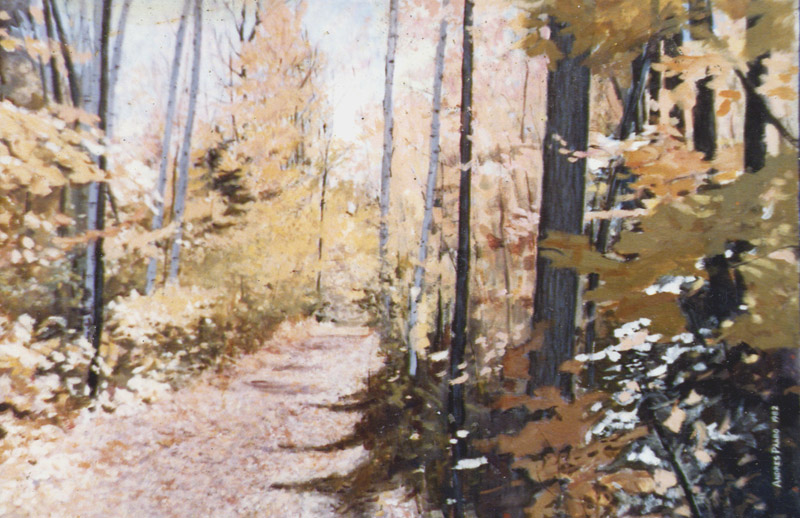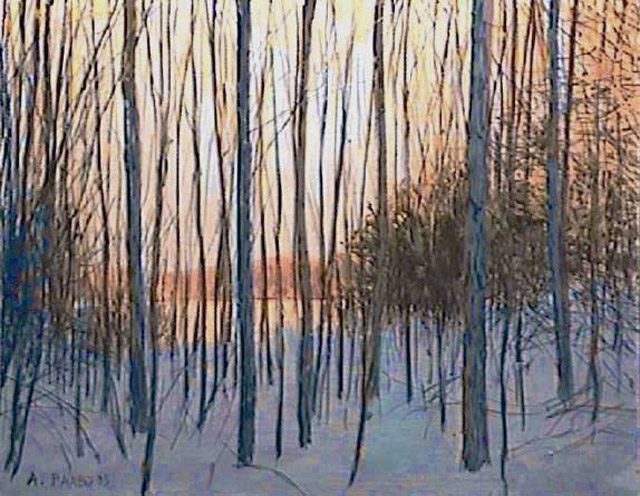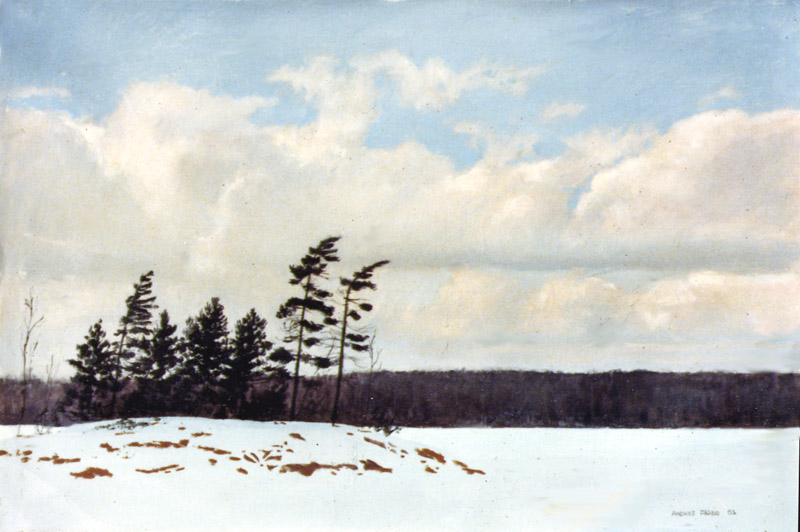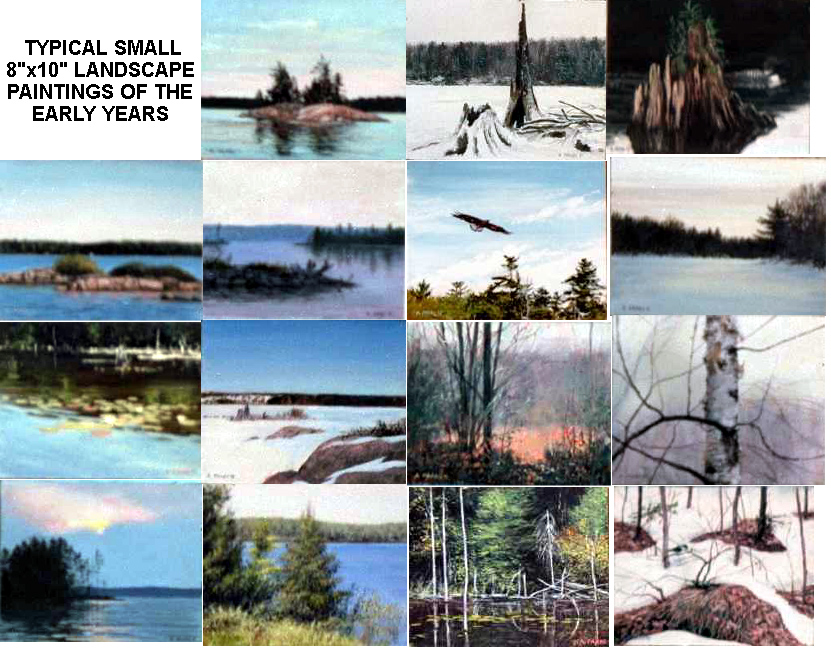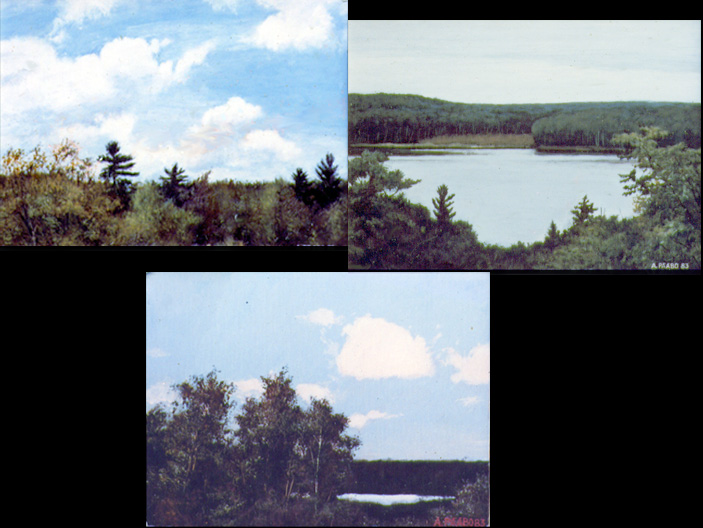< < <
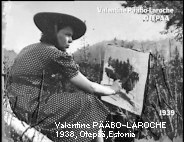 (LEFT) AUNT VALLY FROM A NEWSPAPER
PHOTO IN 1938.
(LEFT) AUNT VALLY FROM A NEWSPAPER
PHOTO IN 1938.
My interest in art had some roots in my aunt Valley. With an education
in art in Estonia, she continued to Paris, which before the WWII was
the center of art culture in Europe. She returned home from time to
time. After the Soviet Union annexed Estonia, she could not return, so
she went to Sweden where my family had gone as refugees, and I was
born. She was
visiting in our apartment when I was two or three. She then returned to
Paris where she lived for the rest of her life. When my family went to
Canada by 1951, it just happened that my ability to draw or paint what
I saw with faithful accuracy, astounded all my teachers, and at home I
was compared to Aunt Vally, some of whose art hung in the livingroom.
With all the reinforcement, it was inevitable that it could go to my
head that I was to become an artist, and I pursued it diligently by the
time I was 10 and on towards my 20's. The following text gives some
more detail and some
illustrations.
1. 1 ARTISTIC ORIGINS AND REINFORCEMENTS
Comparisons to Aunt Vally
When I was growing up in the suburb of Toronto,
called Scarborough, it was difficult for me to avoid being compared to
my Aunt Vally. Several of her paintings were on the livingroom wall and
whenever family friends came to visit, my mother always told me to
bring out some of my artwork to show the guests, and that was followed
by references to Aunt Vally.
There was no pressure on me to become accomplished.
It appears I was naturally talented, since teachers at school marvelled
at my artistic ability since I was only 6. In fact it was the teachers
who drew my parents' attention to my talent. But once it was known, I
was supported and celebrated at every turn. I enjoyed the celebrity at
school during the years 6-10 when it came from my classmates. It made
me feel special in the context of my peers especially since I was
socially reserved - like many people are who are more involved in
observing than participating in activities. My celebrity as an
artist resulted in my father giving me money to buy art materials at
the paint store in the nearby shopping center, which had a corner with
genuine art materials. I told him I needed more brushes or whatever and
he gave me money for it.
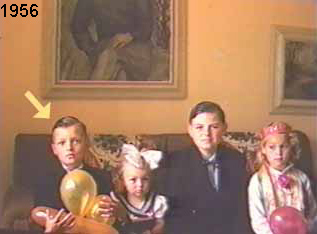
This photo shows Aunt Vally's paintings on the livingroom wall.
I am about 10 and beginning to assume the mantle of 'artist'
My talent at school lead to my school principal
informing my mother of art classes being started in the basement of the
Art Gallery of Ontario, intended for gifted young people of 10-12. Soon
I was excused from classes on Friday afternoons, to take the bus and
streetcar into Toronto to attend these two hour classes. This was
before there were subways. It took a long time to get there, and to get
back, but for a while it was all an adventure.
The teacher, coming over from the
Ontario College of Art, projected his own enthusiasm to us, and
designed each class around a different aspect of art, including colour
theory and art history via a tour of the Art Gallery of Ontario on the
floor above. He put the art I was reading in diverse books and my own
experiements, into real-world context.
This went on until I was
12, and then I was too old. But the teacher informed me of art classes
for high school students being started at the Ontario College of Art on
Saturday mornings. So from ages 13-16 I now travelled on Saturday
mornings during the school year to the Ontario College of Art, which is
around the corner from the Art Gallery of Ontario. I did not like it as
much because students were divided among the various divisions of fine
arts - painting, printmaking, etc - for the entire year. While I wanted
to paint, I found myself stuck
with grinding lithographic stones class after class, in the printmaking
class. I did get into a painting class, however, the following year.
Questioning the
Validity of Calling the Theatrical Trends and Fads in Art as 'Art'
After the classes ended, around noon, I did not want
to head home immediately, and often I explored the Art Gallery of
Ontario. I could not understand the Henry Moore sculptures, nor the
'Pop Art' that was in vogue at the time, but I remember being
fascinated by a large number of small paintings on plywood panels made
by members of the Group of Seven.
I could never understand the silly
developments in the art world, which I call 'static theatre' since that
is what they are. I was well rooted in the true tradition of art, going
back to the prehistoric cave paintings, which was to reproduce and
celebrate reality.For
example, prehistoric cave artists painted bison,
horses, and reindeer to honour them. And that motive continues in
realism - we draw or paint something because we admire them, celebrate
them. Thus if I paint the wilderness, I express a reverence to it. As
the environment became very important in our world over the years,
paintings depicting the natural environment, and wildlife, became
important in society. The kind of celebration of nature and wildlife
embodied by
the paintings of Robert Bateman could not have existed before about the
1970's. Earlier art depicting nature reflected human experience in the
trends since the Victorian Age, to wilderness recreation with canoes,
fishing etc. The Group of Seven captured the experience of the
wilderness recreationist. Animal art in the meantime captured the
experiences of the fisheman and sportsman. It wasn't until the 1970's
that nature was depicted in a naturalist ecological fashion -with the
human observer simply observing, not interfering.. While the wilderness
experience remains strong, the sportsman experience weakened
since the 1970's compared to the naturalist experience.
Realism has always mirrored what a society values.
In past history, going backwards in time, there has been a reverence
towards Greco-Roman themes that were strong during the Renaissance,
before that to scenes from the Christian Bible, before that the ancient
Romans and Greeks celebrated their mythology. I have already
mentioned the celebration of the horses, bison, and reindeer that the
prehistoric cave men worshipped as they were the source of their
survival.
Initial and Continuing
Self-Education in Art
Having come to Canada as an immigrant at the age of
5, I
didn't integrate well with other boys and girls of the mainstream
society. Thus I was pleased that I had an identity as the class artist.
Even before I was sent off to art classes in Toronto, my identity had
been established purely from classmates reinforcing my identity as an
'artist'. So when my father went to the Main Street Library every
couple of weeks - he was an avid reader, tv was very new - I went
directly to the reference section with the large coffee table art books
that could not be loaned out. When my father was through with
collecting his books, I took out three art books from the section
of books available for loaning. He checked them out with his books, and
I had three art books I could study to learn art history, art
techniques, and more. It was in these library visits that I learned
about landscape art, portrait and figure painting, artist anatomy,
animal art, how to draw cartoons, and even commercial illustration. I
was on a servious pursuit of self-education, on top of what I was
learning at those art courses described above.
In my ambition to master art, to impress everyone
all the more, I tried everything shown in the books. I sketched and
painted people, scenery, and birds. I explored cartooning, comic strips
and commercial art. Naively I thought becoming an artist was merely a
matter of education and practice. Sadly I had not considered the nature
of the art world, which by then was trying to re-define art, steer it
away from celebrating reality to shocking the public with disturning
crap shown out of context. (More about that later.)
By the time I took part in the art classes, I was
pretty well oriented to traditional realistic art. There were very few
books about 'abstract' art or the current crazy art trends. That whole
scene was baffling to me. I still view these crazy trends as temporary
cultural developments that will not last. For example, what happened to
'Pop Art'?
SOME OF MY EARLY ART
(Before the internet, and digital
cameras there were few photos. These are made from photos I found.)

PITSY AND MONICA 1960?
I
didn't take photos of my art in those early years. This poor image
reconstructs a typical pastel painting I did of people and birds. I
also experimented with other media, from pen and ink to watercolours to
oil paints.
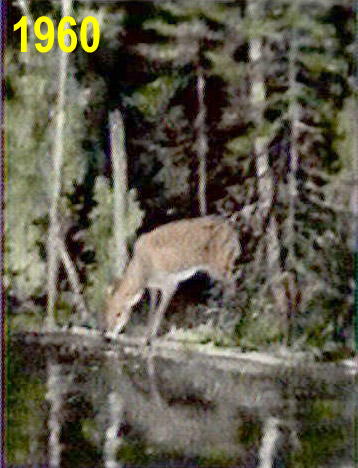
DEER ON OPPOSITE SHORE
After
studying books on 'animal art' I explored introducing animals to
scenes. This is a rare reproduction of one painting into which I added
a deer. This is interesting because it heralds the kind of art I
pursued in much better quality after the 1980's
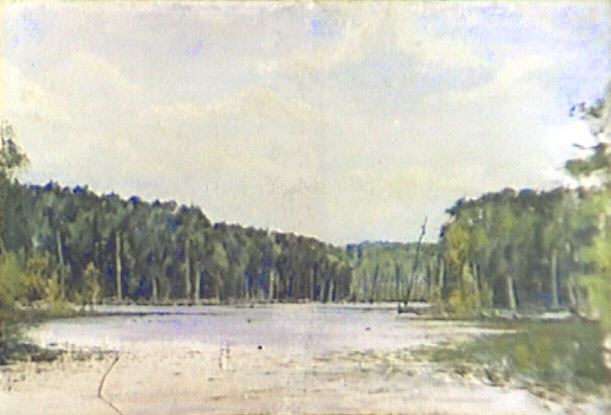
ALDER BAY MARSH
1958?
One of my early paintings painted directly from nature. I parked my
boat in the bay and painted this view of the marsh.
Discovering Some
of the
Fraud in Contemporary Art
As I became accomplished in art, during my
20's I was forced now to look outside art itself, and how it existed in
the world around me.
My next challenge was to figure out how what I was
learning fit
into the current real world. At that time a great deal of fuss was
being made over the Henry Moore sculpture donated to the plaza of
Nathan Phillips Square (Toronto City Hall). Some critics called it the
'Bronze Chicken'. I still do. Let me tell you about Henry Moore - this
British sculpture claimed he was being inspired by the soapstone
sculptures of traditional Inuit peoples in the arctic. I could see
that, but that actually implied the Inuit peoples did not produce art,
but that it had to be a white man from civilization to imitate it
before it became 'art'. I would rather have seen the art establishment
commission actual Inuit artists in the arctic create large sculpures,
instead of all the pretensiousness associated with artists imitating
existing art traditions outside of 'civilization'. So the Henry Moore
sculptures and similar pretentious art for me fell in the same category
as all the 'Pop Art' and 'abstract art'. So much of it was civilized
artists trying to patronize art forms already existing away from the
mainstream art world - rediscovering what already existed, and
presenting it as something new.
My greatest revelation about the pretentiousness of contemporary
art came when I dropped in on an exhibition of art by Toronto abstract
artist Harold Town. In the middle of the gallery there was an old
cracked antique rocking horse he had found somewhere. Around the
gallery walls were interpretations of the rocking horse in various
impressionistic abstract fashion. I found ALL his artistic
interpretations of that rocking horse boring and a joke. The rocking
horse, with its peeling paint and cracked wood was the most interesting
object in the entire show!! By this time, the world had seen the high
realism art of Andrew Wyeth or Ken Danby and I think by this time
imagees by Robert Bateman were just coming to light. All these
realists would have gone the other way -instead of using the rocking
horse as a jumping off point, to produce hundreds of 'interpretations',
the realist focuses on going towards the rocking horse, going inward,
creating a painting that is more penetrating, more real than the
rocking horse itself.
That observation was what ultimately made me realise
that art can respond to reality in two ways - reacting to it,.or
converging on it. Reacting to reality with a thousand different
'interpretations', versus, taking reality and magnifying what is there
via artistic technigues, This discovery eliminated the confusion that
had haunted me in my later art education. I had experimented with the
abstract departures of reality, and felt frustrated. I recall
interpreting a scene with splashes of paint. It looked like a great
semi-abstract painting. But to me it was only the beginning of a
painting. After a few hours of capturing the overall character of my
subject, and achieving something moving, I simply HAD to spend another
hundred hours developing it into a realistic painting. I certainly
could have become a successful abstract artist since it takes a tenth
the time to create a wildly impressionistic semi-abstract landscape
painting, than a realistic painting.
In a sense converging on reality is positive, in
that the artist WANTS to capture everything that is there. It is
impossible to converge, to draw every detail, without being fascinated
with reality - in much the same way a biologist studies an animal. The
other approach, reacting to reality, can produce both positive and
happy reactions, or negative. Harold Towne's reactions were all
positive, but if the subject had been a dead fish, it could have been
negative. But just as converging on reality TENDS to be positive,
reacting to reality TENDS to be negative. Thus ultimately the matter is
not simply converging on reality, or reacting to reality, but of
celebrating (positively) reality, versus condemning (negatively)
reality. Both positivbe and negative are two sides of the same coin.
I have surveyed and come to some conclusions about
the culture of art in humankind since those early years contending with
'abstract art'.
We must not confuse traditional art, based on
celebrating
something important in the real world of our experiences, with static
theatre falsely called 'art' today, that ony lasts as long as society's
fads and trends.
For example, everyone knows how fashion (clothing)
culture is constantly changing. Well art was being redefined in a
similar way - the only different was that it was not worn on the body
by put inside a house. Culture changes, but there has to be a constant.
For example in the clothing fashion industry, the constant is that it
has to be wearable on the human body. Fashion would make no sense if it
included clothing for dogs, cats, pigs and even teapots.So what is the
constant we should find in art? Perhaps that it is 'hangable' in the
human environment. But what kind of environment? Apartment? Large
public space? A street? Unlike fashion, art cannot find a
constant in
the way it is used. That is as variable as putting fashion on a dog vs
a human. Therefore we need another constant. Is it to be outrageous? Is
it to be pleasant and uplifting?
It seems that the only constant is
that art is a direct reaction to reality. "This is how I react to
[something]-". It can be positive or negative. To gave a place in
society at large, and not just to the artist, that [something] has to
be relevant. The [something] could be Christ, to which a society reacts
positively thru its art. Or the [something] can be bison, to which a
prehistoric hunting society reacts positively to honour the bison. Or
the [something] can be the polluted environment of today to which an
artist can react negatively by depicting the ugliness of pollution -
dead fish, plastic islands in the oceans, etc - or the artist can react
positively by depicting the disappearing pure pristine untouched
wilderness. Whether a society prefers the positive (showing Christ,
pristine wilderness, etc) or negatively (showing Satan, scenes of
polluted landscapes) depends on what the public prefers. Both are
necessary - one contrasts the other - so that if we speak of
environmental art, it is wise to have the negative art shown in venues
where the public looks at it and then goes home, and the positive art
hung on home walls which are by nature positive sanctuaries. Thus
speaking of the trends in the 1980's, it was perfectly valid for the
very positive environmental art reproduced in prints to be consumed by
the general public for their homes, while the start, distrubing,
nagative reactions to the polluted environment remained in the
theatrical art world which the public consumed only for short periods
of time. There is nothing incompatable with human culture, for positive
art to be purchased by the public for their home sanctuaries while
still accepting the negative reactions being presented in the museums
and galleries. Culture is formed by the two together. It is the case in
fashion too. The fashion shows will present outlandish fashions women
will not wear in daily life, while the retail clothing stores present
the kinds of practical clothes the general public prefers to use in
regular life.
The Group of
Seven Established the Tradition of Painting the Canadian
Wilderness
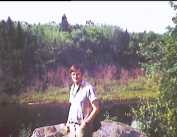
In my years of self-education, I followed the art
world in the media, and I dropped into art galleries in Toronto. I
especially liked dropping in at the Roberts Gallery on Yonge Street,
where landscape realism prevailed.
Canadian nature art has at its foundation the works
of the artists who formed the 'Group of Seven'. At that time I believe
two of them were still alive. When an exhibition of new art by one of
them was mounted at the Roberts Gallery, collectors lined up and when
the doors were opened rushed to claim any work on the wall, simply
because any 'Group of Seven' art was now valuable.
I saw in the Group of Seven, my way out of the
morass of crazy theatrical behaviour falsely called 'art' (As I said
above, it should be called 'static theatre'. For example an
installation of urinals in an art gallery is not 'art', but a contrived
theatrical event designed to rob stupid wealthy people of their money.)
So I was inspired to paint landscapes of central
Ontario, where my family had a cottage, in an 'impressionistic' fashion
like the 'Group of Seven' had done a half century earlier.
But, is impressionism not a reaction to a reality?
Is ot really realism like painting the antique rocking horse above?
This question arose in my mind also when I considered where native art
belonged? I found an easy way to answer the question.
Consider portraying a person. A portrait of a
person by its nature has to converge, not depart, from the subject. A
portrait has to get closer to the subject in order to capture the
uniqueness of the person. The same would apply to painting a
portrait of a wild animal, such as a loon. The artist has to converge
on the details of the loon in order that it captures the uniqueness of
the loon, and the painting does not look like a generic dark waterbird.
This same truth applies if we portray a person in a
caricature. Caricatures can be made from a few lines, and still look
like the person being portrayed. When native artists reduce an image of
a loon to simple shapes and lines, they must still capture the reality
or else it will not be identifiable as a loon. So native art simplifies
the subject, without taking away from what makes the subject
identifiable. Some of the best exampls can be found in the cave
paintings of southern France. The images of bison, although simplified
look very real.
Thus realism is about describing the reality, trying
to capture as much of its truth as possible. It does not depart from,
react to, reality, journeying to another place.
In this light, landscape paintings that reduce a
scene to bands of paint, some lines, some textures, can similarly
capture the essence of the reality like a caricature. Even if when
squinting it may look like an abstract, it still captures the reality.
The viewer who has experienced such scenes, will immediately identify
the reality.
Bearing this in mind, I discovered that all art has
a foundation of good design. The human psychology reacts to colours,
shapes, lines, textures etc. On top of that we can add symbolism, and
narrative. Even the most high realism art has the good design
underneath that affects the viewer's emotions. For realism it is
important that the artistic technique that produces the emotions, has
to be consistent with any further symbolism and narrative placed on
top. For example, if our scene wants to produce sunny feelings, it
better use the colours and symbols most commonly generating such
feelings.
To summarize, realism is about converging on the
subject matter, trying hard to capture its essense, regardless of
whether the painting is simplified or with exaggerated detail. (The
artist has to decide what level of detail is most suited to the subject
matter.)
1.2
MY MASTERY OF PORTRAIT
PAINTING BEFORE THE 1970s
Portraiture was one of my earliest interests because
once I was in high school, I found I could try to make some pocket
money sketching portraits of schoolmates and in summer of our cottage
neighbours. As a result I mastered portraiture first, and actually had
a few significant oil portrait commissions in my teen years. Following
the established practices, I painted my subject in from two to five
sittings. Each sitting could be about two hours.
Thus when I explored making money from my art, I
mainly looked towards portrait sketching and painting. But by my
mid-teen years I was able to put a few landscape paintings in a couple
of places in Toronto. But mostly my display and sale of landscape
paintings was at the family summer cottage, where the owner of the
marina, Reg Armstrong, happily put my art on the wall of the store, and
made it the subject of conversation with cottagers who visited the
store. I painted small scenes from around the lake and assigned prices
of around $100 (which could be about $300 in today's money). Many were
sold. In addition, a portrait painting was put on show as well, and
from that came several portrait commissions. This activity occurred in
summers of 1961-64. I was 15-18 years old and this was a pretty good
summer business.
In general in my teenage years I had managed to have
my own business, both in summer and during the school year, making
pocket money with my art.
LANDSCAPE AND PORTRAIT
PAINTING: TWO
SIGNIFICANT TALENTS THAT LAID THE FOUNDATION
FOR MY
ENTRY INTO "WILDLIFE" OR "ENVIRONMENTAL" ART A
DECADE OR SO LATER
ARMSTRONG MARINA
FROM INSIDE THE BAY
In 1964 acrylic paints were new. This
was one of my early use of acrylic paints. The painting was done on
site. I set up in the marsh and painted while swatting mosquitoes.
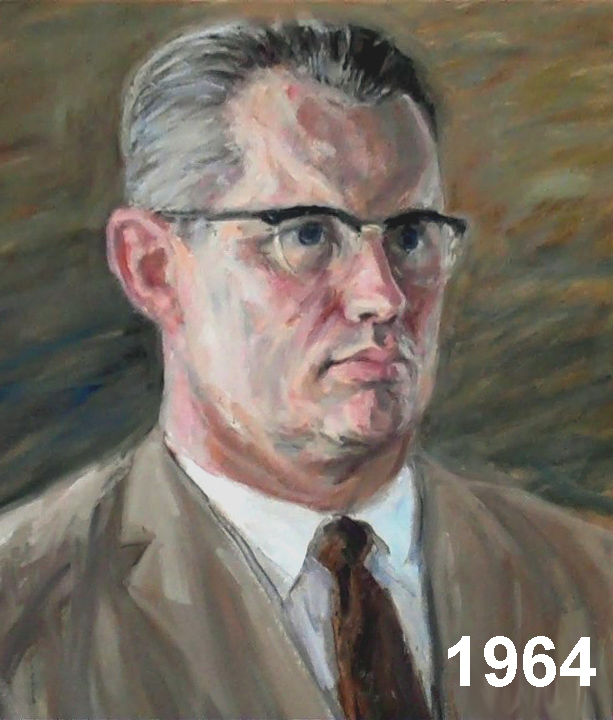 M. JACKSON PORTRAIT
16" x 20"
This was one of the more significant
oil portraits I painted in the
summer of 1964. It involved five sittings and the price converted to
today's money value was about $500. Most of my portraits to
neighbouring cottagers were charcoal sketches.
M. JACKSON PORTRAIT
16" x 20"
This was one of the more significant
oil portraits I painted in the
summer of 1964. It involved five sittings and the price converted to
today's money value was about $500. Most of my portraits to
neighbouring cottagers were charcoal sketches.
While my skills in painting landscapes was obviously
important when I expanded into the new genre of 'wildlife art' from the
1980's onward, it is not as obvious how important my mastery of portait
painting was as well. Portait painting gave me the discipliine of
analyzing anatomy and developing an eye to accuracy which preadapted me
to portraying animals. Humans, after all, are animals too. The
following shows some examples of my mastery of oil portraits.
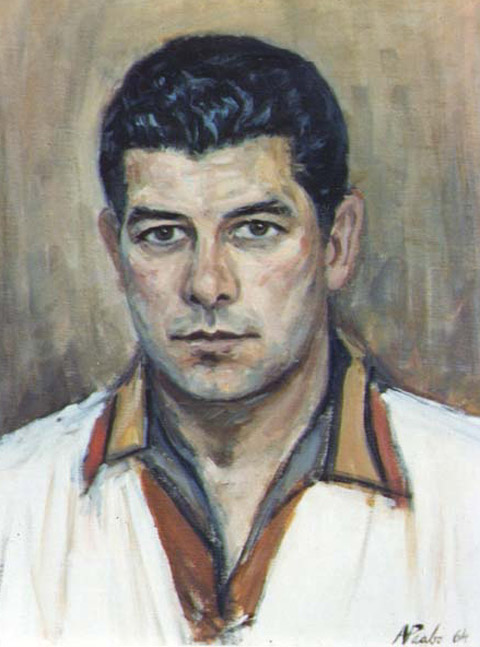
PORTRAITS
OF THE ANIMAL CALLED "HUMAN BEING"
(right)"Reg"
1964 One
of my more developed oil portraits from my teenage years shows how
accomplished I was in painting portraits by my mid-teens.

(left) "Yvonne" (my cousin) 1969 This painting, done when I was about
23, shows how
I had
mastered portrait painting. But at that time, there was no living to be
made in the art world, and I was busy trying to determine what I would
like to pursue as my 'regular' career. My pursuit of art was suspended
for the next number of years
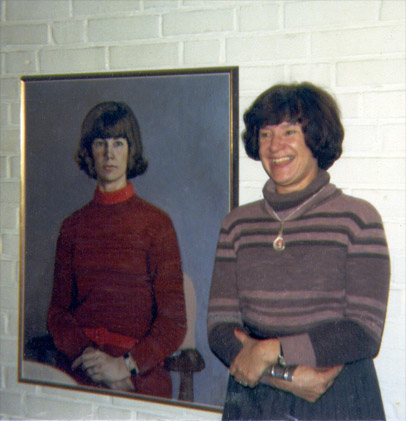
(right)"Irene"
1969. This painting with the subject beside the painting, compares the
painting to the subject.
I already also
learned from the library books human
anatomy, and a little animal anatomy too, so that when I began to draw
and paint mainly wild animals, I already had the knowledge and
experience required. Thus when I committed myself to wildlife art
from the late 1970's I have both the skills for painting the animal, as
well as the skills for painting landscapes. I only needed to combine
the two. Earlier sections of this presentation have already showed
those results. Here I will focus on the animal portraits.
LITTLE
KNOWN FACT: HE CHARGED WELL IN THE
1960's!
Andres
P��bo painted large formal portaits already in his teenage years, and
was charging a good amount. He recalls that in around 1963 his charge
for a major portrait painting involving 5 sittings was $350, which in
today's inflated money, some 50 years later was close to $2000. Small
portraits like the head and shoulders paintings above were around $65,
which is close to $500 in today's money.
|
This education into portrait painting made it easy
for me to portray animals - to study their anatomy, capture their
character, etc. This with my dual talents of portaiture and landscape
painting, I was preadapted to immediately enter the world of wildlife
art that presented animals in their habitats, or environments with
animals in them.
1.3 MY
STRUGGLE TO DECIDE ON MY FUTURE
However, the real world does not support artists very well. As in all
fields of art, one becomes successful only when you become established
and a celebrity. Most artists had some conventional profession to make
a living, and pursued art in their spare time. The number of artists
who were famous enough to make a living from art was small.
LITTLE
KNOWN FACT: HIS COUPLE YEARS IN
ADVERTISING 67-68
Andres P��bo spent almost two
years after high school (1967-68) in the creative
department of a major Canadian advertising agency creating advertising
and several were produced and aired or published in print. That is the
origins of his advertising and writing creative ability that he applied
in the late 1990's in website design when the internet appeared.
|
That was the reality I was facing as I was ending my
high school years.
I considered what kind of profession I could pursue
to give me security. One of the obvious possibilities was commercial
art. By that time I had explored comic strips. Even though I could
never come to a decision, I went ahead to take the subjects in my high
school years required for entry into a scientific or engineering course
at university. By this time, my brother was pursuing civil engineering
at the University of Toronto. My father was a chemical engineer. So
that was my default reaction to preparing for the future.
When I actually graduated from high school, I was
determined to stay within the world of art, and one day decided to see
if I could get a job in commericial or advertising art. Filling up a
portfolio of my accumulated work, including comic strips and cartoons,
I began dropping in cold to several ad agencies and asking the
receptionists if there was an art director available to have a look at
my portfolio.
Just by chance, I walked into a major Canadian ad
agency (F.H.Hayhurst) around lunch time. Unknown to me, this agency was
booming. They were expanding. The creative director was about to have
his lunch, so agreed to see me. Taking me into his office, he went
through my portfolio, and was especially impressed by my comic strips.
"In advertisting,":he said, "we need people who are good with both
words and images" and he saw this skill in me.
Ad agencies would normally only consider applicants
with either a degree in writing, or art. Normally creative departments
contain teams of writers and artists, but it was desirable if a writer
could visualize, or an artist could create a narrative. This creative
director saw in me someone who was almost equally capable in both. So
he gave me two assignments. One assignment was to create a storyboard
for a tv commercial for Mennen shaving lotion I think, and the second a
print ad for I believe Heinz soup (or was it Aylmer).
I went home and created these ads and I either
dropped them off or mailed them to him.
As I said, the company was successful and expanding.
I was the first applicant for expansion of the creative department -
even before the offices where prepared. So he gave me a job 'assisting
both writers and artists'.
After some months, when the new offices were
finished, he gave me an official title 'junior artist-copywriter', and
I was given an office to work in. I realized my strength was more in my
being a writer who could visualize on paper, and so, I made a great
effort in creating the storyboards of layouts for my own ideas. The
regular writers had to hand their typewritten copy to their artists.
But I could do it all. I stood out, and some resented it.
I was there for two years, but while it was an okay
profession, and I could have continued, becoming an advertisting genius
in several years, it was not satisfying. Gradually I was exploring
other opportunities. For example, I was considering architecture.
Architecture calls on creativity. There was also the reality that my
brother and both parents had graduated from universities.
LITTLE
KNOWN FACT: PROFESSIONAL ENGINEER
(ONT) IN 1983
Andres
P��bo enrolled in the Faculty of Applied Science and Engineering at the
University of Toronto in 1970, and pursued civil engineering, building
science and planning division, until graduation in 1974, and then
worked in various capacities in the general area and the final firm he
was at, got him certified as a "Professional Engineer" Province of
Ontario Canada. HIs early fondness for painting nature, plus a
recession and unemployment was the stimulus to give it up to become a
poor 'wildlife artist' in the wilderness of Central Ontario.
(There
were several invitations over the next years for him to return to
engineering-planning, but he turned them down citing his need to see if
he could make it as a wildlife artist.)
|
So after a couple years I departed from the company
with the intention of studying at the University of Toronto. Finding
the first year of the U of T school of architecture repeating the art
education I already had, I investigated the nearby Faculty of Applied
Science and Engineering. I would learn the engineering side of
architecture, I told myself, and then combine it with my creative side
to end up as an architect.
Later I would discover that few buildings are designed
creatively, Most building design follows standard designs and
techniques - because it is cheapest - and I would not find any
creativity in that direction. Thus I abandoned the plan of designing
buildings, and as I completed my degree in civil engineering, I steered
myself to the new field of urban plannning and design.
After graduating I began searching for something
creativet in the working world. Eventually I arrived at urban planning
and design, achieving the title of "Jr. Planner-Engineer" and learning
all about the world of zoning bylaws and urban planning. I became a
registered 'Professional Engineer" in the Province of Ontario.
1.4 A POSSIBLITY SUGGESTED BY NEW
ENVIRONMENTAL ART TRENDS
Meanwhile, there was a significant development in
the world of art. An artist named Robert Bateman was creating realistic
paintings of environments and animals. These images were
published as limited edition lithographic prints and were all the rage
in North America. This was a new kind of portrayal of animals and
nature from a naturalist angle. All former illustrative art depicting
animals were geared to sportsmen - showing bucks on hills waiting for
the bullet, or a large fish waiting to be hooked. Robert Bateman's
naturalist images were appealing to anyone interested in nature. It was
about this time too that 'environmentalism' was growing. His images
came along at the right place and time. Furthermore, Bateman aspired to
traditions of realism. He had like me once investigated the 'Group of
Seven' and tried impressionistic landscapes. He too, had to find a
regular profession to make a living. (He became a school teacher.) and
was not able to pursue art full time until he was successful.
So I think to myself - 'that is what I always liked
to do!' I saw in his work an opportunity to not just return to art, but
also possibly being successful. The limited edition lithograph
phenomenon was so popular that artists capable of creating the
naturalist paintings with the appealing narratives could publish
limited edition offset lithograhic prints and distribute them to the
same outlets that were handling the Bateman prints.
But I needed a push to embark on this new direction.
That push came from the economic downturn of the early 1980's. It was a
recession that saw the planning consulting firm for which I was working
stumble along with limited staff. During this time, my parents having
passed away, II became owner of one of the family cottage properties.
From 1976 onward I used every weekend or vacation opportunity to go
there and adapt it to become my studio. I was already beginning
to enter this new world of wildlife art before the 1980's. By 1983 I
was creating some major paintings like the one in the photo below,
which I aspired to eventually turn into a limited edition offset print.
Essentially I began painting traditional landscapes
in more detail, and
fitting appropriate wildlife into the scene. I sold them at art
festivals, and when I managed to have some significant images
published, I began advertising those images and distributiing to
framing shops, etc, who were interested in this new kind of art.
(Framing shops had good business in framing up the limited edition
wildlife art prints in those days.)
Finally the company for which I worked closed down,
and
I was faced with two options - to find another job in the planning
field, or to make my artistic pursuit fulltime. In 1985 I gave up my
Toronto accomodation and began to live
full time at my cottage to do it fulltime. I realized that if I didn't
I would always wonder if I would have succeeded had I done so. So the
attitude I had was that at least if I didn't succeed to make a living
this way - albeit at a much smaller income than I was recieving as a
professional engineer - I would have been happy that I tried.
Some
Early Paintings from around
Early 1980's before I committed to this Path full time
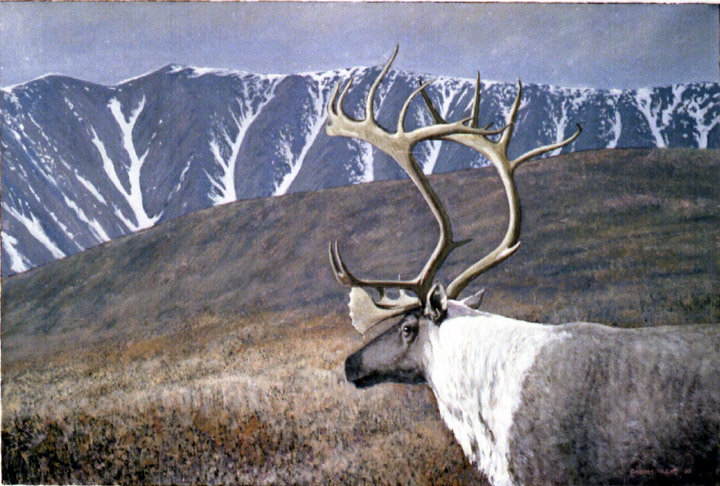 ANTLERS IN THE MOUNTAINS
ANTLERS IN THE MOUNTAINS
This is another major painting, this
one visualizing a concept that came to me from a photo in a magazine
showing antler-like snow in the background mountains. This was a large
painting dated to 1982
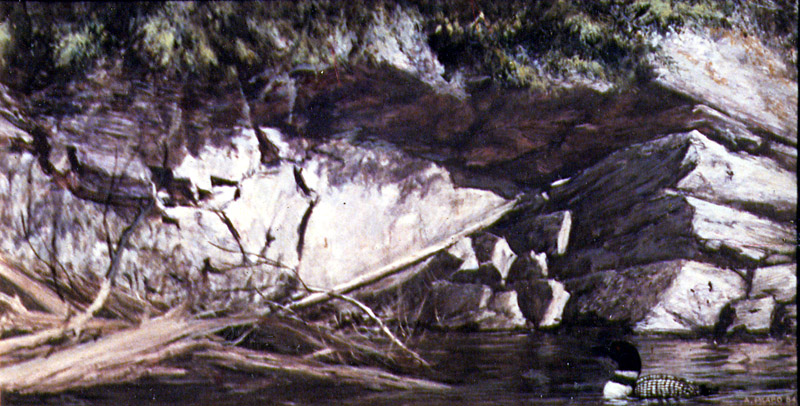 SHORE ROCKS
SHORE ROCKS
1982
This
is another painting from my early work, done I think as early as 1981.
In this case, I was exploring how naure could be the source of
interesting designs. Although I added a loon, it lacks the narrative
with the animal that most people like.
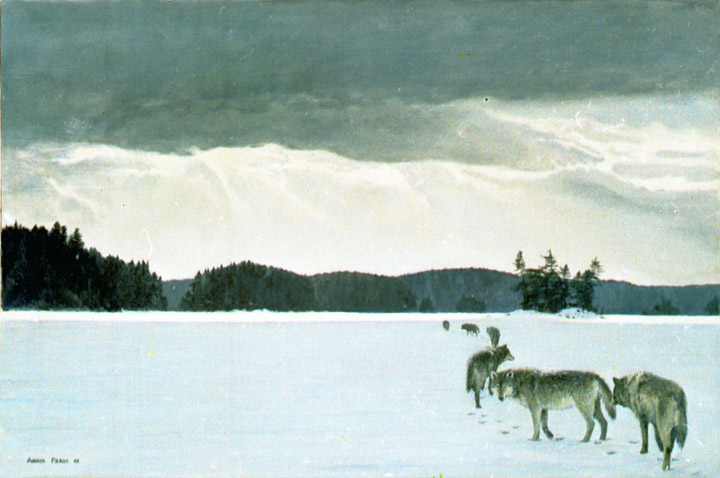
FIRST VERSION OF UNDER NORTHERN SKIES
1983 36" x 24:
This painting from 1983, is my first version of depicting an ominous
winter scene on a lake, which adds to it a line of wiolves. While this
sold well, I saw ways to improve the design, from adding a foreground,
to tightening up the line of wolves. To see the final version of 1993,
which was finally published as a limited edition, see the section of
wildlife or on prints.
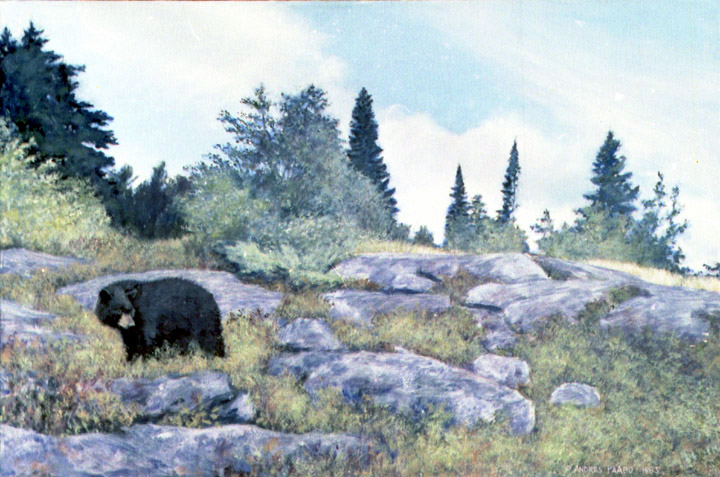
BLUEBERRY HILL - BLACK BEAR
This
is another early painting, I believe dated to around 1983. It is
large and on canvas. Purchased by the Budds, it was loaned out, and the
person who loaned it has kept it whether from a misunderstanding or
some other reason. Contact me to resolve the issue if you know of its
whereabouts.
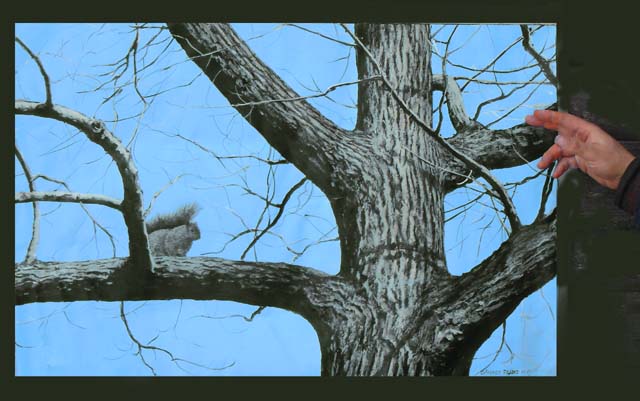
HOME SWEET TREE
1980(?)
One of my earliest paintings - from about 1980 - that explored creating
a design using natural subject matter and then turning it into a
narrative involving a squirrel. This was inspired by trees and
squirrels in Queen's Park, Toronto
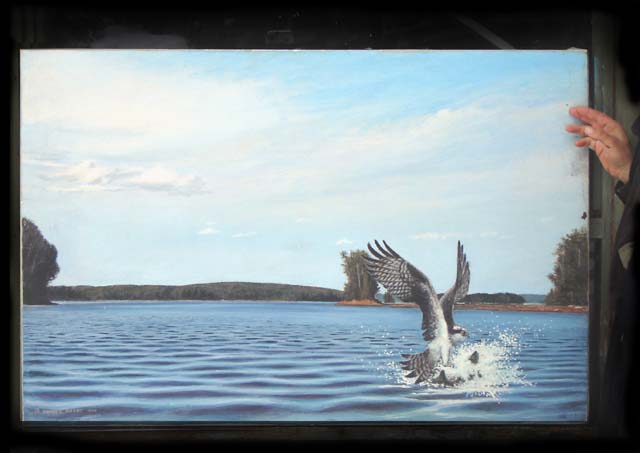 OSPREY BAY 42" x 28" AROUND $1700
OSPREY BAY 42" x 28" AROUND $1700
This was an ambitiouos attempt to describe a common event in Alder Bay
- ospreys landing in the water and pulling up a fish. This is a very
large painting as the hand indicates. As I will mention later, large
paintings were difficult to sell because most people do not have the
wall space for large paintings.
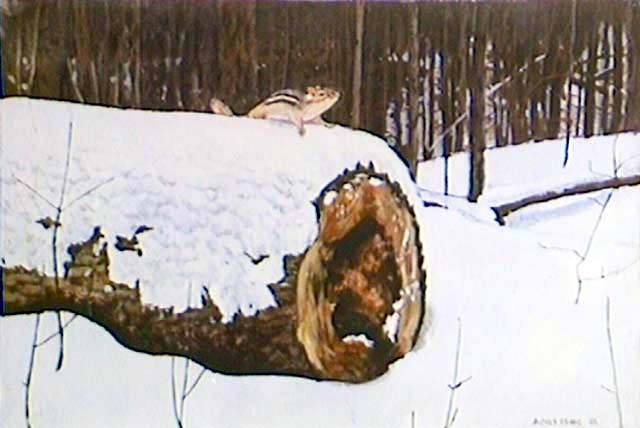
SPRING CHIPMUNK 30"x 20"
This
painting was inspired by a log I saw beside the road I walked to
reach the marina. Spring was arriving and snow was melting. Chipmunks
might emerge to see if the ground was clear of snow anywhere. Since
chipmunks feed off the forest floor, this use of a chipmunk might be a
little contrived.
Typical Small Landscapes from Before 1985
Since I was already accomplished in painting quick
landscapes for an affordable price, and they sold well, and they were
part of studying subject matter in planning more serious paintings, I
did not cease creatiing them - expecially when I continued to find
people around the cottage country still liked them. Here is a selection
of small paintings from around 1983-4. See in later sections for small
paintings done in later years.
Some
typical exampes of the kinds of
landscape paintings I created in the transition period - 1984-1985 - to
sell to the general public in and around my cottage/studio. Some of
these paintings might be from a little later. The images are of two low
a resolution to see the dates on them.
SEE LATER PAGES FOR BETTER PHOTOS OF LATER SMALL PAINTINGS
Some of these examples above might date to a bit
later than before 1985. There was never a sharp transition like there
were with devoting to wildlife art. The trouble in the 1980's was that
there were no digital cameras, and to take photos of art, one had to
set up the art and take traditional film photos, then get them
developed into prints for great expense and discovered half were off.
Therefore I hardly ever photographed the quick small landscapes.
But a couple of times I lined up small paintings, and took a film photo
of about 9 in one photo, just to get a record. This mosaic is created
from a couple such photos. In the next stage, I was able to take
digital images with a camcorder connected to a digitized connected to
the Amiga computer. This allowed me to get low resolution digital
images at no cost and which I could process in the computer. But sadly,
I have very few photographs from before digital cameras appeared.
Therefore the images shown here tend to be of better resolution and
greater quantity for the years 1995 onward in the next section of this
biography.
Thus to summarize - I continued to create small
landscapes when the mood struck me, even as I ventured into large
landcapes on canvas, and landcapes involving wildlife. The reason was
very simple - the large canvases had to be priced several times higher
than the small landscapes and that constricted my market. Therefore
when after 1985 I exhibited at art festivals, I made certain that half
of my paintings were small landscapes. The serious large wildlife art
tended to mainly demonstrate my capability, and promote sales of
limited editons, and if some wealthier art enthusiast came along and
bought the masterpiece, well that was a bonus. But clearly before the
limited editions became popular, and after the limitied edition market
declined, the small landscapes were my bread-and-butter.
1.5 COMMITTING TO WILDLIFE ART
AND LIMITED EDITIONS BY 1985
By the summer of 1985, being unemployed because of a
recession
occurring in the early 1980's. and having now managed to place wildlife
paintings (such as the early Under Northern Skies) into galleries, I
made all the arrangements necessary to move permanently to the
cottage/studio, and give up my Toronto address. Even though it might be
a struggle, I realized I had to at least try, or else always wonder if
I could have been able to make a living with art, instead of continuing
on a path in Planning.
My first year living in the north Kawartha
wilderness was a challenging one. I had not experienced an entire
winter there - I was situated about a half a kilometer from where
snowplowing of roads ended. Every day, I walked to the marina and
interracted with its owner, Reg Armstrong, who was also in the habit of
living there through the winter, whereas cottagers only came there
sporatically on weekends to run their snowmobiles.He had plenty of food
in his store, and he was happy I was using up his old inventory.
I discovered early that I didn't have enough wood
for heating, and I had to adopt a habit of looking for standing
deadwood, cut it down, and drag it home, where I cut it up in the
evening. I burned it in the cookstove left over from my early days
being a cottager. It had an oven, and I learned to make bread, since
Reg lacked fresh bread, but had flour.
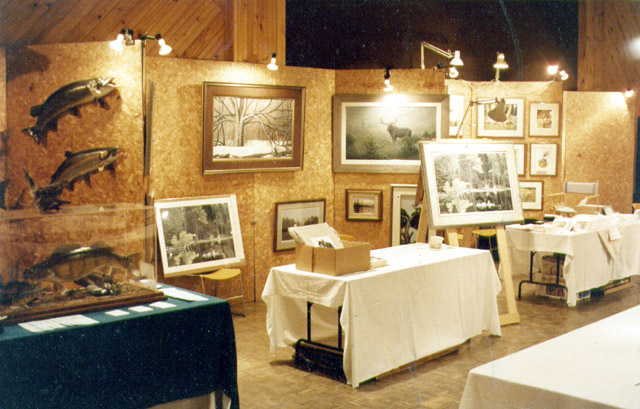
The real challenge would come in the spring, when it
was necessary for me to set out making contacts with art galleries and
registering in art festivals where I could sell the art I had created
through the winter. I already had some contacts from the previous years
where I had divided my time between here and Toronto. While creating
the paintings were challenging, it was actually the easy part. The
difficult part was to make a living from it. The various art shows -
usually weekend shows in different parts of Ontario - sold booth space
in which to hang art or crafts to sell. Because at this time the
wildlife art and limited edition trend was at its peak, these art shows
were often oriented to wildlife. The most important one to me, as it
was only 45 minutes drive away, was the Buckhorn Wildlife Art Festival.
At its peak it was attracting wildlife artists from all over North
America, and also wildlife art enthusiasts. I was in that festival I
believe by 1986 and it became an annual habit to appear there.
But there were many other shows, some smaller, some larger, some
enduring and some lasting only a few years. Between becoming known via
the shows, putting art into galleries in Toronto, and marketing my
limited edition, I was able to survive okay in the decade from 1985-95
to being one of political movements in the world of art experts who
couldn't paint, or art sellers who could not do anything more than
pursue money. It was a world in which outrageous crap could be deemed
'art' and wealthy people conned into spending large amounts of
money
on it. I recall quite a few decades ago, a news item in which
renovators of a small New York gallery had left a pile of bricks in the
corner of the gallery, and visitors had taken it to be a work of art
with a profound statement. Well I was not surprised when recently many
decades later, a similar news item appeared - unfinished renovations in
a gallery being assumed to be art - to give readers a chuckle.
Today
any stupid thing can be called 'art' as long as it is taken out of its
normal context - such as putting a pile of bricks indoors - and someone
generates some profound meaning to it. I sound cynical, and yes, it was
this cynicism that made me steer away from art as I approached my 20's
and saw what the art world had become. As I will describe further in
this autobiography, I departed art to pursue something more realistic
and practical - urban -planning and engineering - until the rise of
wildlife/environmental art distributed via limited edition reproduction
marketing that bypassed all the institutional a-holes in the art world
that sought to control how the public saw and consumed art. Thus from
about 1980 for a decade or two, I was re-inspired towards art.
The
above was written
in March 2016 - Andres P��bo
contact: A.Paabo, Box 478,
Apsley, Ont., Canada
2016 (c) A. P��bo.
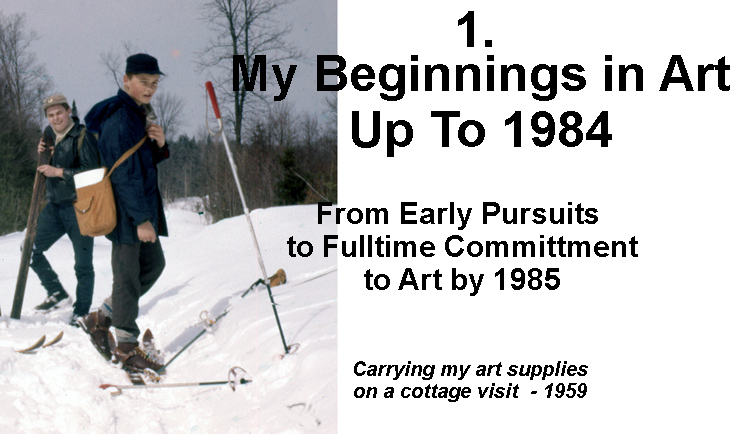

 (LEFT) AUNT VALLY FROM A NEWSPAPER
PHOTO IN 1938.
(LEFT) AUNT VALLY FROM A NEWSPAPER
PHOTO IN 1938.












